Bryn Battersby1
Over the past 40 years, Australia’s labour productivity level relative to the United States has trended slowly upwards. However, there remains a substantial gap between Australian and United States labour productivity levels. The persistence of this gap has raised questions about whether there are factors that might limit the extent to which Australia can catch-up to the United States.
To explain this gap, there is growing interest in the hindrances that might be imposed by Australia’s unique geographic isolation and vastness. If the level of labour productivity is constrained by geography, then the scope to close the productivity gap with the United States is also constrained.
This paper summarises some recent Treasury work that has sought to quantify the extent to which Australia’s geography explains the productivity gap with the United States. This work has found that Australia’s geography might explain as much as half of the productivity gap with the United States.
Introduction
In 2002, the Australian Government released the first Intergenerational Report, which outlined both the opportunities and the risks for the Australian economy well into the future, with a particular focus on the impact of an ageing population on economic growth and budgetary outcomes. To aid in that analysis, economic growth was deconstructed into three key drivers — population growth, changes in participation rates in the labour force, and labour productivity growth. This deconstruction has come to be known as the three-Ps framework and has been the focus of much research in Treasury and elsewhere.2
This paper outlines work that has sought to contribute to the understanding of the third of these three-Ps: labour productivity.3 Over the last 40 years, Australia’s labour productivity relative to that of the United States has been slowly trending up (as Chart1 demonstrates). However, there continues to be a substantial gap between the Australian and United States labour productivity levels. Given that the United States represents the frontier of labour productivity in many sectors, the factors underlying this gap have been seen as a potential source of short term gains to Australia’s labour productivity as Australia catches up with the United States. However, the persistence of this gap has frustrated those hopes and raised questions about whether there are factors that might limit the extent to which Australia can catch-up to the United States.
If limiting factors do exist, they would help to explain the persistence of the labour productivity gap between Australia and the United States. More importantly, this added context around the story of Australian labour productivity may help to identify where policies might be targeted appropriately to ensure Australia’s labour productivity is optimal.
This paper explores the role that geography might play in limiting Australia’s labour productivity catch-up with the United States. Australia has a geography that is both sparsely populated and remote, which creates a set of impediments that are unique in the context of developed countries. If geography does limit our ability to catch-up with the United States, then it should be possible to observe this by applying one of the standard models of labour productivity; including a variable that captures the difference in remoteness and vastness between Australia and the United States; and testing whether that variable matters in the scheme of the model.
Chart 1: Australian labour productivity as a proportion of the United States
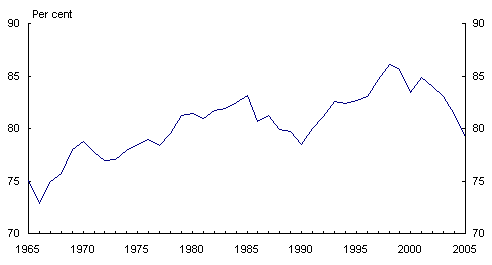
Source: The Conference Board and Groningen Growth and Development Centre, Total Economy Database, May 2006, http://www.ggdc.net.
In what follows, the reasons why geography might matter in limiting Australia’s labour productivity catch-up with the United States are outlined. In the third section, differences in labour productivity, physical capital, human capital, and geography are compared across the states of Australia and the United States. That analysis results in a key finding: perhaps up to half of the productivity gap between Australia and the United States is explained by the remoteness and sparseness of Australia.
Why would geography matter?
Before entering into the empirical analysis, it pays to consider why geography might limit the level of labour productivity in Australia relative to the United States. In Budget Statement 4 of the 2003-04 Federal Budget, the effect of Australia’s isolation on labour productivity was considered:
… to a greater extent than for many other countries, resources will be allocated to activities where distance confers natural protection by decreasing the competitiveness of imported goods or services. As a consequence, Australia’s relative levels of productivity may be behind global best practice in these areas.(p 4-22)
This section builds on this statement and provides a case that Australia’s geography affects the ability of many Australian firms to achieve full internal and external economies of scale. However, it is also argued that this does not preclude the existence of these firms because geography also acts as a natural barrier to trade and allows them to exist profitably (in much the same way a tariff might act as an artificial barrier to trade and allow inefficient firms to exist profitably).
Full internal economies of scale arise when unit costs of production for a firm stop falling as output increases. For many small firms, production has to increase only slightly before full internal economies of scale are reached. In these cases, the market for the firm is likely to be only sub-national. This means that a country’s population will usually have no effect on a small local firm’s ability to profitably reach full internal economies of scale.
For other firms, production can increase substantially before full internal economies of scale are reached. In these cases, operating profitably may require a very large and accessible market, which may not be present domestically. For most countries, there is little reason to expect that this market will be limited to just the local population if the country has a generally open economy. Indeed, large companies that take advantage of internal economies of scale are regularly supported by global markets of suppliers and consumers.
However, transport and trade costs might naturally make an economy more closed and this could create a potential for a national or local scale effect. This could quite well be the case for Australia — a country that is geographically isolated and sparsely populated. Australia’s remoteness from large markets means that firms in some industries in Australia are unable to achieve the same economies of scale as those in the same industries in Europe or North America. Reciprocally, the costs of trade for international producers make them less competitive in Australian markets. This higher ‘world price’ in some Australian markets makes Australian firms in related industries profitable without having to achieve the same economies of scale. While this is still an economically efficient outcome, it does mean that some Australian firms will be less productive than similar firms based in larger markets.
Firms can also take advantage of external economies of scale to lower their costs. External economies of scale allow firms to reduce unit costs in production through commonality in
production and distribution processes with other firms and through spill-overs in innovation between firms. Geographic agglomeration of economic activity and economic networks are regular sources of this scale. However, firms in countries like Australia, which are both geographically isolated and sparsely populated, may be less able to take advantage of these external economies of scale simply because it is more costly to establish networks over the great distances both within the country and to other countries.
The hypothesis that geography matters is therefore underpinned by a microeconomic reference to the additional costs of participating in the Australian market and the effect these costs have on any firm’s ability to operate profitably in Australia. In the next section, aggregate labour productivity is examined in a standard model to identify whether this microeconomic hypothesis is borne out in the aggregate data.
Estimating the effect of geography
To ascertain whether geography matters, it was necessary to construct an econometric model that tested for a relationship between labour productivity and geography. The standard economic model of labour productivity normally describes a simple relationship between labour productivity and physical and human capital. In this relationship, the more physical capital that is provided in production (such as machinery and equipment), the more productive people are expected to be (though at a diminishing rate). The same sort of relationship is modelled between labour productivity and human capital — the more educated, skilled and healthy a person is, the more productive they will be, other things held constant.
In this analysis, one further variable is added to the standard model, which describes the geography of the economy. It is possible to say that geography matters under the conditions that the necessary labour productivity and capital intensity data are appropriate; the construction of the geography variable is acceptable; and the geography variable is statistically important in the econometric model of labour productivity. If these requirements are met, it is then also possible to tentatively estimate the importance of geography and the implications for policies that target labour productivity growth.
Below, we consider each of these requirements separately using data from each of the states in Australia and the United States.4
In Chart 2, the productivity levels (output per hour worked) of the states of Australia and the United States are presented. The data that were used to account for physical and human capital in explaining these labour productivity levels are presented in Chart 3 (the stock of physical capital per hour worked) and Chart 4 (number of bachelor degrees per thousand hours worked). Based on the standard model of labour productivity, it would be expected that those states that have higher capital to labour ratios in Charts 3 and 4 are generally those that have higher labour productivity levels in Chart 2. As it turns out, while there are exceptions, this pattern is recognisable.
Chart 2: Australian and US state labour productivity, 2001
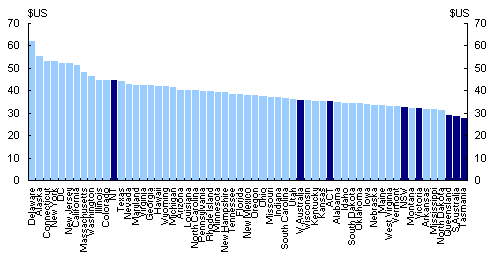
Source: Treasury calculations.
Chart 3: Australian and US state physical capital to labour ratio, 2001
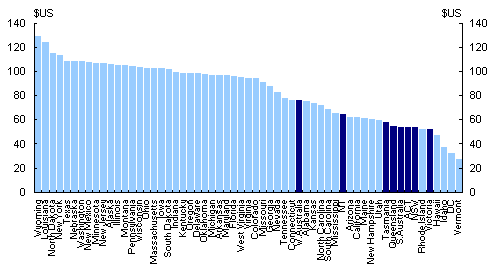
Source: Treasury calculations.
Chart 4: Australian and US state human capital to labour ratio, 2001
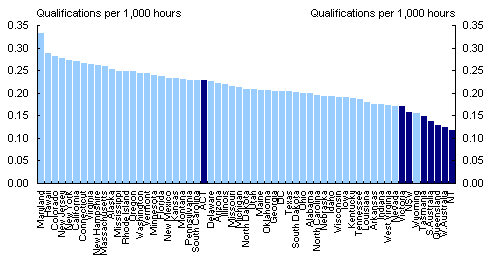
Source: Treasury calculations.
The final variable in this analysis captures the geography of each state of Australia and the United States. The features that are described by the geography variable (which, in this analysis, is called the ‘proximity indicator’) are the economy’s remoteness from other economic activity around the world and the degree of economic activity that goes on at home.
The proximity indicator that was developed for this analysis is presented in Chart 5. The construction of the indicator required a calculation using the following three sets of data for each state:
- the extent of economic activity in different areas of the world;
- the distance from the state to that economic activity; and
- a rate at which the importance of economic activity around the world decreases as the distance to that economic activity increases.
A final, but important note on the construction of the indicator is that the size of each state was included in each state’s indicator. Thus, states that are economically large but surrounded by economically smaller states continue to capture the effect of essentially being proximate to their own economy. In this sense, a state like Tasmania would be both geographically remote and economically small, which would result in a relatively low proximity indicator. On the other hand, a state like New York would be the very opposite, given its large home economy and location in the heart of the economic activity of the east coast of North America.
Because of the complex nature of this construction, the actual value of the proximity indicator (on the Y axis in Chart 5) is quite difficult to interpret, but this value is rather tangential to the analysis at hand. It is more useful to consider the comparative values of proximity between the states. In this sense, the proximity variable indicates that New Jersey’s proximity to economic activity is somewhere around 30 times greater than Tasmania’s. The variable also indicates that Victoria is about as proximate to economic activity as Wyoming or North Dakota, which stresses the importance of the size of the own state economy in the construction of the proximity indicator.
Chart 5: Australian and US state proximity indicators
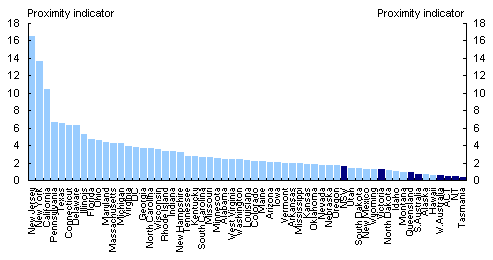
Source: Treasury calculations.
With the inclusion of the proximity indicator, the development of the dataset was complete and ready for analysis. Using these data, we set about estimating the extent to which the proximity indicator in Chart 5 explained labour productivity in Chart 2, while accounting for physical and human capital to labour ratios presented in Charts 3 and 4. In the next section, the results of that process are outlined.
Results
The results from the estimation of the labour productivity model using the data presented in the previous section suggested that there was a significant relationship between labour productivity and geography. In statistical terms, the parameter on the proximity variable was positive and significant, implying that those states with higher proximity indicators tend to have higher labour productivity (if the physical and human capital to labour ratios are held constant). This result supported the motivating hypothesis that differences in geography help to explain differences in labour productivity.
With the statistical relationship established, it was possible to estimate the extent to which the gap in labour productivity between Australia and the United States could be explained by Australia’s remoteness and vastness. By applying these statistical results to overall Australian and United States labour productivity equations with an av
erage proximity indicator for both countries, it was then possible to tentatively establish that around 45 per cent of the gap might be explained by the differences in the two countries proximity indicator.
This result must be treated with a great deal of caution for two key reasons. Firstly, the data that were used in this analysis were built from sectoral data for the states of Australia and the United States. However, the sectors for each of the countries were inconsistent, and some manipulation and exclusion of data was required to make the aggregate compositions comparable.
Secondly, a range of technical assumptions had to be made in the construction of the proximity indicator. Treasury Working Paper 2006-03 details these assumptions in some length and shows that the point-estimate of 45 per cent is sensitive to changes in those assumptions. Importantly, the significance of the geography variable itself is far less sensitive to changes in these assumptions. In the end, this implies that geography certainly does matter, but that it is difficult to identify confidently its exact contribution to the labour productivity gap between the United States and Australia.
Conclusion
The key result of this work is the identification of a statistical relationship between labour productivity levels and geography. This result suggests that Australia’s labour productivity level is constrained by Australia’s vast and remote geography.
To be clear, this result does not suggest that there is an inevitable ceiling for Australia’s level of labour productivity. Australia’s potential for productivity growth can be deconstructed into the potential for Australia’s productivity frontier to continue to expand (through innovation and new technologies) and Australia’s capacity to reach its productivity frontier. The result of the analysis outlined in this article suggests that Australia’s productivity frontier might be somewhere inside that of the United States’, but it does not give any reason to doubt that Australia’s frontier will continue to expand at the same rate as that of the United States. This expansion will continue to be driven by the ongoing creation of new technologies and innovative work practices, both in Australia and around the world, and the adoption of these technologies and practices in Australian workplaces.
The result in this paper can also be turned around to make the point that more than half of Australia’s productivity gap with the United States is not explained by geography. This implies that there may yet be considerable scope for Australia to still reach its own productivity frontier.
The result of this work also creates a range of new questions. For instance, at the start of this article, some of the likely channels through which geography might affect labour productivity were outlined. But to what extent do these various channels explain the result that is presented in this paper? Is this predominantly a story of constrained internal economies of scale, or limited external economies of scale? Or is there some other channel through which Australia’s vastness and remoteness affects the level of labour productivity?
It is also often argued that the impact of distance has declined over time and will continue to decline into the future. This is clearly true in particular cases, such as in the transport of refrigerated goods. However, while these falling costs will continue to improve the wellbeing of Australians, it is not clear that this sort of technological change will necessarily help Australia close the labour productivity gap with the United States. This is because the lower costs from this technological change apply to all countries, which means it becomes cheaper to not only run a business in remote locations, but to also service remote locations from the centres of world economic activity. Further work will be required to identify which of these two effects is dominant with particular changes in technology.
Finally, this work also raises questions that extend beyond just the domain of labour productivity. If geographic factors can shape labour productivity outcomes so obviously, what does this mean for other economic activity and outcomes? We might expect capital to labour ratios will look different in remote areas under a similar hypothesis to that contained in this work. Similarly, we might also expect that the rates of return to other types of investment, such as research and development, may also be different.
Given that the result in this paper suggests that more than half of Australia’s productivity gap with the United States is not explained by geography, these are clearly very important questions. Their answers will ultimately provide better guidance on where policies might be best targeted to ensure the ongoing growth of Australian labour productivity which, itself, will be a platform for sustained improvement in wellbeing throughout Australia.
1 The author is from Macroeconomic Policy Division, the Australian Treasury. This article has benefited from comments and suggestions provided by Greg Coombs, Graeme Davis, JohnHawkins, Jyoti Rahman, Dominic Regan and Joann Wilkie. The views in this article are those of the author and not necessarily those of the Australian Treasury.
2 The Economic Roundup has presented much of this research: see pages 154-6 of this Roundup.
3 This paper summarises the findings presented in the Treasury Working Paper 2006-03: Does distance matter? The effect of geographic isolation on productivity levels. That paper provides a detailed exposition of the data and analytical methods that underpinned this research.
4 Using data from Australia and the United States is useful in this type of analysis because of the general similarity in policies and culture between the two countries. Countries that have significantly different policies and cultures would require additional variables to capture these differences to ensure that the results are not statistically biased.